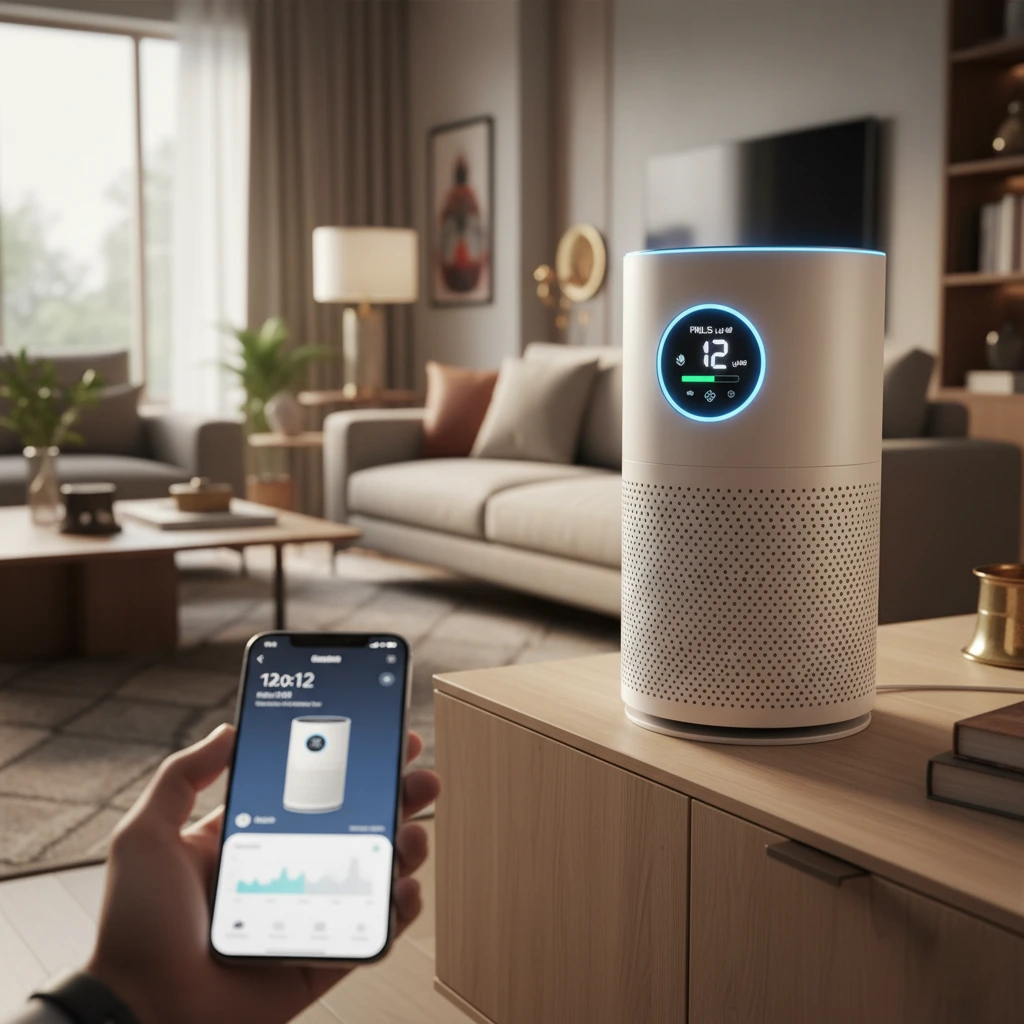Do Smart Air Purifiers with IoT Really Work in Indian Homes?
In an age where our homes are becoming increasingly connected, it's no surprise that even essential appliances like air purifiers are getting a smart upgrade. Gone are the days of simply pressing an 'on' button; modern air purifiers now boast IoT (Internet of Things) capabilities, allowing for remote control, real-time air quality monitoring, and automated functions. But the burning question for many Indian consumers, grappling with some of the world's most severe air pollution, is: Do smart air purifiers with IoT really work in Indian homes? Are these advanced features more than just a gimmick, offering genuine benefits and effective purification against the unique challenges of urban Indian air?
The promise of a smart air purifier is compelling: a device that not only cleans your air but also understands your environment, learns your habits, and provides actionable insights, all accessible from your smartphone. From tracking PM2.5 levels in real-time to integrating with voice assistants, these intelligent devices aim to make clean air effortless. This in-depth blog post will explore the functionality, effectiveness, and practical implications of smart air purifiers with IoT in the context of Indian households, helping you determine if this connected clean air revolution is truly worth embracing.
Understanding the "Smart" in Smart Air Purifiers
Before evaluating their effectiveness, let's break down what makes an air purifier "smart" and how IoT plays a crucial role. IoT refers to the network of physical objects embedded with sensors, software, and other technologies for the purpose of connecting and exchanging data with other devices and systems over the internet.
For air purifiers, this typically translates into:
Wi-Fi Connectivity: The core enabler, allowing the purifier to connect to your home network and, subsequently, the internet.
Mobile App Control: A dedicated smartphone app (e.g., Mi Home, Philips Clean Home+, Dyson Link) acts as the central hub for managing the purifier from anywhere.
Real-time Air Quality Monitoring: Built-in sensors detect pollutants like PM2.5, VOCs (Volatile Organic Compounds), and humidity, displaying the data on the device itself and in the app.
Automated Operation (Auto Mode): Based on sensor data, the purifier can automatically adjust fan speeds to maintain optimal air quality without manual intervention.
Scheduling and Timers: Set specific times for the purifier to turn on/off or change modes according to your daily routine.
Filter Life Tracking: The app monitors filter usage and alerts you when it's time for replacement, often linking directly to purchase options.
Voice Assistant Integration: Compatibility with platforms like Amazon Alexa and Google Assistant for hands-free control.
Historical Data & Insights: The app often provides historical air quality data, allowing users to track trends and understand pollution patterns in their homes.
These features move beyond basic purification, aiming to provide convenience, informed decision-making, and optimized performance.
The Unique Challenges of Indian Homes and Air Quality
Indian homes face a distinct set of air quality challenges that make the role of an air purifier even more critical.
High Ambient Pollution: Major Indian cities consistently rank among the most polluted globally, leading to significant outdoor-to-indoor pollution ingress.
Diverse Indoor Pollutants: Besides outdoor smog, indoor air is affected by cooking fumes (especially traditional Indian cooking with spices and oil), incense burning, mosquito coils, cleaning agents, pet dander, and construction dust.
Varying Home Structures: From modern apartments to older, less insulated homes, the ability of outdoor pollution to infiltrate varies greatly.
Power Fluctuations: Frequent power cuts and voltage variations can affect the continuous operation of appliances.
Connectivity Issues: While improving, stable Wi-Fi connectivity across all parts of a home can still be a challenge for some.
Given these complexities, the question isn't just "Do they work?" but "Do they work effectively and reliably in this specific environment?"
The Effectiveness: Where Smart Features Shine in Indian Homes
1. Real-time Monitoring & Informed Decisions: This is perhaps the biggest advantage. A smart air purifier with an integrated PM2.5 sensor provides immediate, accurate feedback on your indoor air quality. In Indian cities where outdoor AQI can fluctuate wildly, knowing your exact indoor PM2.5 level is invaluable.
Scenario: You might think your home is clean, but a sudden spike in outdoor pollution or residual smoke from cooking could push indoor levels into unsafe zones. Your smart purifier's app will show this instantly, prompting you to close windows or increase fan speed.
Actionable Insight: Users can cross-reference indoor data with local outdoor AQI reports (e.g., SAFAR India app) to understand the ingress of external pollution and take preventive measures like sealing gaps.
2. Automated Operation for Seamless Protection: The auto mode, driven by IoT sensors, is incredibly effective. The purifier senses deteriorating air quality and automatically ramps up its fan speed, then slows down once the air is clean.
Benefit: This saves energy by not running at full power unnecessarily and ensures continuous clean air without constant manual adjustments. It's especially useful for working professionals or families with children who can't constantly monitor the device.
3. Remote Control & Scheduling: Imagine coming home from a polluted commute to a pre-purified room. Remote control allows you to turn on the purifier an hour before you arrive. Scheduling ensures clean air during critical times like sleep or during specific cooking hours.
Practicality: For multi-story homes or large apartments, controlling multiple purifiers from a single app is a huge convenience. Forget to turn it off after leaving for work? No problem, just use the app.
4. Filter Life Tracking & Maintenance: Filters are the heart of an air purifier, and their effectiveness diminishes over time. In India's high-pollution environment, filters often need replacement sooner than standard recommendations. Smart purifiers accurately track filter usage and notify you when it's time for a change.
Advantage: This prevents you from running the purifier with clogged, ineffective filters, ensuring consistent performance and prompting timely maintenance, which is crucial for the longevity of the device and your health.
5. Integration with Smart Home Ecosystems: For tech enthusiasts, integrating with voice assistants like Alexa or Google Assistant offers hands-free control. "Alexa, turn on the living room air purifier" or "Hey Google, set the bedroom purifier to auto mode" adds a layer of convenience. While still a niche for many Indian households, its adoption is growing.
Potential Drawbacks and Considerations for Indian Users
While the benefits are clear, there are a few considerations:
Reliable Wi-Fi Connectivity: Smart features are only as good as your internet connection. In areas with inconsistent Wi-Fi, some features might be unreliable.
App Dependency: If you prefer simple, button-based operation, being tied to an app for advanced features might not appeal.
Security Concerns: As with any IoT device, there are inherent (though often minimal) data privacy and security risks. Choosing reputable brands helps mitigate this.
Initial Setup Complexity: Some users might find the initial pairing process with their home network and app a bit challenging.
Cost: Smart air purifiers generally cost slightly more than their non-smart counterparts. However, many brands like Xiaomi, Coway, and Blueair offer excellent smart models under ₹15,000.
Real-World Examples and Stats
Leading brands like Xiaomi (Mi Air Purifier series), Philips (Clean Home+ models), Honeywell (Air Touch series), Blueair (DustMagnet), and Coway (Airmega series) offer robust smart air purifiers that are popular in India.
Xiaomi Mi Air Purifier: Known for its competitive pricing and comprehensive app integration, often providing real-time PM2.5, temperature, and humidity data.
Philips Smart Air Purifiers: Utilize their Clean Home+ app to offer features like filter alerts, air quality history, and remote control.
Dyson Purifiers: While typically above the ₹10,000 budget, Dyson's models are pioneers in integrating sophisticated sensors and app control for whole-home purification insights.
A survey by IDC India on smart home devices indicated a growing interest in connected health devices, including air purifiers, with convenience and health monitoring being key drivers for adoption among urban Indian consumers.
Internal Linking Suggestions:
"To understand more about why PM2.5 is so dangerous, check out our guide on [Why Air Purifiers Will Be the Hottest Gadget This Diwali in Delhi NCR]."
"Considering a smart air purifier on a budget? Explore our list of [Top 5 Upcoming Air Purifiers in India Under ₹10,000 (2025 Models)]."
Conclusion: A Smart Investment for Smarter Living
So, do smart air purifiers with IoT really work in Indian homes? The resounding answer is yes, they absolutely do. In a country where air quality is a significant health concern, the added intelligence of IoT-enabled air purifiers transforms them from simple appliances into proactive guardians of your indoor environment. The ability to monitor, control, and automate purification, coupled with features that ensure optimal performance and timely maintenance, makes them an incredibly effective tool for combating both external pollution ingress and internal contaminants.
While a stable internet connection is a prerequisite, the benefits of convenience, energy efficiency, and informed decision-making far outweigh the minor challenges. As technology continues to evolve and prices become more accessible, smart air purifiers are not just a futuristic gadget but a practical, intelligent investment for any Indian household serious about ensuring clean air and a healthier future. Embrace the smart air revolution and breathe easier, knowing your home is protected by cutting-edge technology.
Ready to make your home smarter and healthier? Discover the best smart air purifiers available and take control of your indoor air quality today.
Frequently Asked Questions (FAQs)
Q1: What are the main benefits of a smart air purifier over a regular one?
A: The main benefits of a smart air purifier with IoT include remote control via a smartphone app, real-time air quality monitoring, automated operation (auto mode) based on sensor readings, filter life tracking and alerts, and often integration with voice assistants. These features provide greater convenience, optimize performance, and ensure you're always aware of your indoor air quality.
Q2: Do I need a strong Wi-Fi connection for a smart air purifier to work?
A: Yes, a stable and reliable Wi-Fi connection is essential for a smart air purifier's IoT features to function correctly. Without a consistent internet connection, features like remote control, real-time data updates, and app-based scheduling may not work, essentially turning your smart purifier into a regular, non-connected device.
Q3: Can smart air purifiers really help against severe pollution like in Delhi?
A: Yes, smart air purifiers with high-quality HEPA and activated carbon filters are highly effective against severe pollution, including PM2.5 and harmful gases prevalent in cities like Delhi. The "smart" features enhance this by allowing you to monitor and react to pollution spikes in real-time, ensuring the purifier is always working optimally to protect your indoor environment.
Q4: Are smart air purifiers more expensive to maintain due to technology?
A: The core maintenance cost of a smart air purifier (filter replacement) is similar to non-smart models with comparable filtration technology. While the initial purchase price might be slightly higher, the smart features themselves don't typically add to ongoing maintenance costs. In fact, filter life tracking can help optimize usage and potentially extend filter life by preventing unnecessary replacements.
Q5: What are VOCs, and do smart air purifiers effectively remove them?
A: VOCs (Volatile Organic Compounds) are harmful gases emitted from sources like paints, cleaning products, cooking, and building materials. Many smart air purifiers in Indian homes include an activated carbon filter specifically designed to absorb VOCs, odors, and other gaseous pollutants. While no purifier can remove 100% of all VOCs, a good activated carbon filter significantly reduces their concentration, improving indoor air quality.
External Authoritative References:
World Health Organization (WHO): For global air quality guidelines and health impacts of pollution. [Link to WHO website]
Central Pollution Control Board (CPCB), India: For national air quality standards and data. [Link to CPCB India website]
IQAir: For real-time air quality data and reports on global cities. [Link to IQAir website]
IDC India: For market insights on smart home device adoption in India. [Link to IDC India research/reports]





